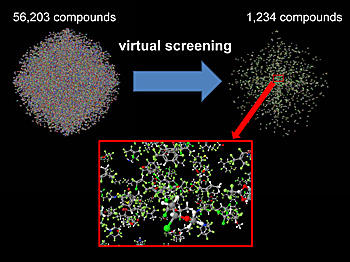
To help industry find refrigerant fluids with low global warming potential (GWP), NIST researchers screened 56,203 compounds and identified 1,234 candidates for further study.
Researchers at the National Institute of Standards and Technology (NIST) have developed a new computational method for identifying candidate refrigerant fluids with low "global warming potential" (GWP)—the tendency to trap heat in the atmosphere for many decades—as well as other desirable performance and safety features.
The NIST effort is the most extensive systematic search for a new class of refrigerants that meet the latest concerns about climate change. The new method was used to identify about 1,200 promising, low-GWP chemicals for further study among some 56,000 that were considered. Only about 60 of these have boiling points low enough to be suitable for common refrigeration equipment, an indication of how difficult it is to identify usable fluids.
The ongoing NIST project is a response to U.S. industry interest in a new generation of alternative refrigerants that already are required for use in the European Union.
The refrigerants now used in cars and homes are mainly hydrofluorocarbons (HFCs). They were adopted a generation ago in the effort to phase out chlorofluorocarbons (CFCs), which deplete the stratospheric ozone layer. An example is R-134a (1,1,1,2-tetrafluoroethane), which replaced ozone-depleting chemicals in automobile air conditioners and home refrigerators. R-134a now is being phased out in Europe because HFCs remain in the atmosphere for many years, yielding a high GWP. A compound's GWP is defined as the warming potential of one kilogram of the gas relative to one kilogram of carbon dioxide. R-134a has a GWP of 1,430, much higher than the GWP of 150 or less now mandated for automotive use in Europe.
Promising low-GWP chemicals include fluorinated olefins, which react rapidly with atmospheric compounds and thus will not persist for long periods.
"What industry is trying to do is be prepared, because moving from a GWP in the thousands or tens of thousands to a GWP of 150 is an enormous challenge, both economically and technologically," says NIST chemist Michael Frenkel. "We decided to leverage the tools NIST has been developing for the last 15 years to look into the whole slew of available chemicals."
The affected industry is huge: The U.S. air conditioning, heating and refrigeration equipment manufacturing industry ships about $30 billion in goods annually, according to the U.S. Bureau of the Census.
NIST has extensive experience evaluating alternative refrigerants, having previously helped the refrigeration industry find replacements for CFCs.
The new NIST method estimates GWP by combining calculations of a compound's radiative efficiency (a measure of how well it absorbs infrared radiation) and atmospheric lifetime, both derived from molecular structure. Additional filtering is based on low toxicity and flammability, adequate stability, and critical temperature (where the compound's liquid and gas properties converge) in a desirable range. The method was applied to 56,203 compounds and identified 1,234 candidates for further study. The method, which was validated against available literature data, is accurate and fast enough for virtual screening applications. The approach is similar to the large-scale virtual screening and computational design methods for discovering new pharmaceuticals.
The screening is the initial stage of a larger study funded by the U.S. Department of Energy. The next step will be to further narrow down the candidates to a couple dozen suitable for detailed investigation in refrigeration cycle modeling.
A. Kazakov, M.O. McLinden and M. Frenkel. Computational design of new refrigerant fluids based on environmental, safety, and thermodynamic characteristics. Industrial and Engineering Chemistry Research. Article ASAP, Publication Date (Web): September 4, 2012. DOI: 10.1021/ie3016126

